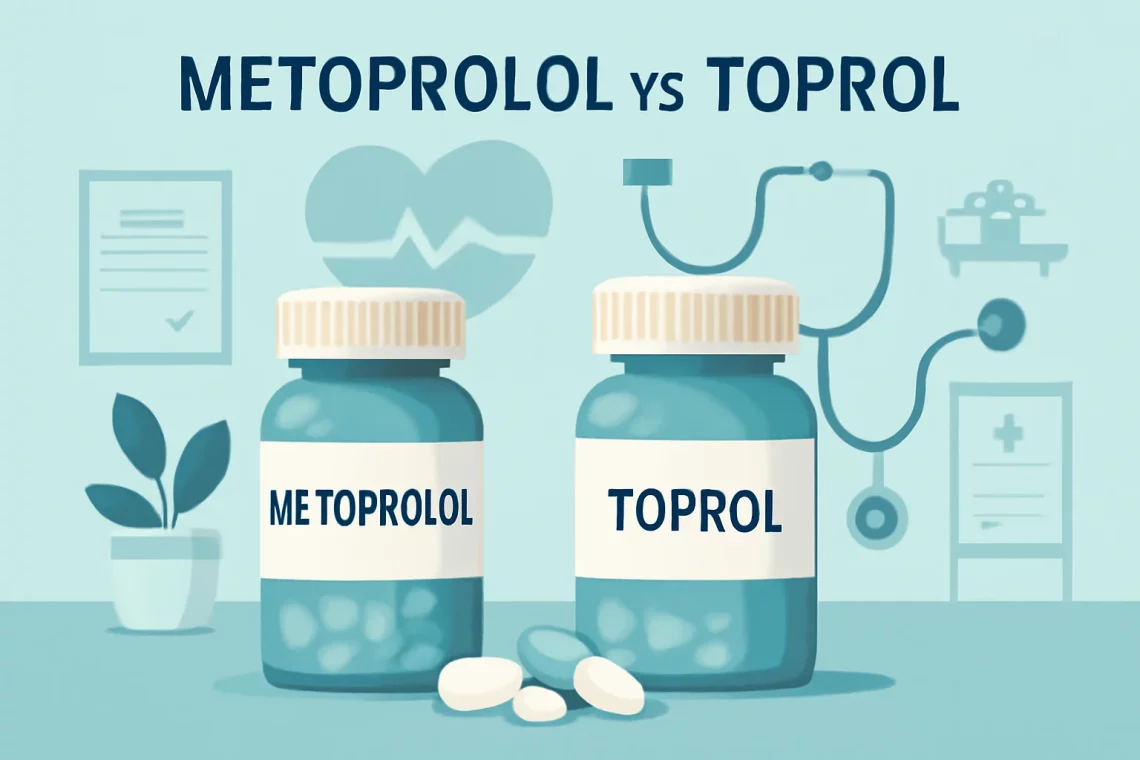
Metoprolol vs Toprol: Understanding the Key Differences and Uses
Metoprolol and Toprol are two terms often used interchangeably in the world of cardiovascular medications. These medications belong to a class known as beta-blockers, which are primarily used to manage high blood pressure, heart rhythm disorders, and other heart-related conditions. Despite their similarities, it is crucial to understand that Metoprolol and Toprol, while closely related, are not exactly the same. Their differences can significantly impact how they are prescribed and how they function in the body.
Beta-blockers like Metoprolol work by blocking the effects of adrenaline on the heart and blood vessels. This action leads to a decrease in heart rate and blood pressure, making it easier for the heart to pump blood. For many patients, this can be life-changing, as it helps manage conditions that could otherwise lead to serious health complications. However, the choice between Metoprolol and its branded counterpart, Toprol, may depend on several factors, including a patient’s specific health needs, the potential side effects, and the overall treatment plan. As we delve deeper into the distinctions and implications of using Metoprolol versus Toprol, it becomes clear that understanding these medications can empower patients and healthcare providers alike to make informed decisions about heart health.
Understanding Metoprolol
Metoprolol is a selective beta-1 adrenergic receptor blocker that is primarily used to treat conditions such as hypertension, angina, and heart failure. It plays a vital role in managing cardiovascular diseases by reducing heart rate and myocardial contractility, which ultimately leads to decreased oxygen demand by the heart. This mechanism is particularly beneficial for patients with ischemic heart conditions.
One of the key features of Metoprolol is its ability to lower blood pressure effectively. By inhibiting the action of catecholamines, such as adrenaline, Metoprolol helps to relax blood vessels, making it easier for blood to flow. This can significantly reduce the risk of heart attack and stroke in patients suffering from hypertension. It is available in both immediate-release and extended-release formulations, allowing for flexible dosing based on individual patient needs.
Patients taking Metoprolol may experience side effects, which can include fatigue, dizziness, and gastrointestinal disturbances. However, many individuals tolerate the medication well, and the benefits often outweigh the potential drawbacks. Healthcare providers typically monitor patients closely, especially when initiating therapy or adjusting dosages, to ensure optimal results.
It is essential for patients to communicate with their healthcare providers about any pre-existing conditions, such as asthma or diabetes, as these may influence the decision to prescribe Metoprolol. Additionally, those considering stopping the medication should consult their physicians, as abrupt discontinuation can lead to significant complications, including rebound hypertension.
In summary, Metoprolol is a cornerstone in the management of various cardiovascular conditions, but its use must be tailored to the individual patient’s medical history and response to treatment.
The Role of Toprol
Toprol is the brand name for Metoprolol succinate, which is an extended-release formulation of the same active ingredient. The significance of this distinction lies in the pharmacokinetics of the drug. Toprol is designed to provide a gradual release of Metoprolol into the bloodstream, allowing for once-daily dosing that can enhance patient compliance. This is particularly advantageous for individuals who may have difficulty remembering multiple doses throughout the day.
The extended-release nature of Toprol means that it maintains more stable blood levels of the medication, which can lead to improved control of blood pressure and heart rate. Patients taking Toprol may notice that they experience fewer fluctuations in their symptoms compared to those on immediate-release Metoprolol formulations. This consistent therapeutic effect can be particularly important for those managing chronic conditions, as it helps to stabilize their overall health.
Despite its benefits, patients using Toprol should still be aware of potential side effects, including those similar to Metoprolol, such as tiredness, dizziness, and mood changes. Again, individual tolerance will vary, and it is crucial to maintain open communication with healthcare professionals regarding any adverse effects experienced.
Furthermore, Toprol may not be suitable for everyone. For example, patients with certain heart conditions or those taking specific medications may require careful monitoring or alternative treatments. As with any medication, the decision to use Toprol should be made collaboratively between the patient and their healthcare provider, considering all factors involved.
In conclusion, while Toprol is an effective option for many patients, it is essential to understand its specific characteristics and how they may align with individual health needs.
Comparing Metoprolol and Toprol
When comparing Metoprolol and Toprol, the most significant difference lies in their formulation and release characteristics. While both medications contain the same active ingredient, Metoprolol is available in both immediate-release and extended-release forms, whereas Toprol is solely an extended-release formulation. This distinction can influence the choice of medication based on the patient’s lifestyle, adherence to treatment, and medical conditions.
Another factor to consider is the dosing frequency. Metoprolol immediate-release typically requires multiple doses throughout the day, which can be cumbersome for some patients. In contrast, Toprol’s once-daily dosing makes it a more convenient option for those who prefer a simpler regimen. This convenience can lead to better adherence to the treatment plan, potentially resulting in more effective management of the patient’s condition.
Side effects are also a critical consideration in the comparison of these two medications. While they share many common side effects, the extended-release formulation of Toprol may result in a lower incidence of peaks and troughs in drug levels, which can minimize side effects for some patients. However, individual responses can vary widely, and what works well for one patient may not be ideal for another.
Cost and insurance coverage are additional factors that may influence the choice between Metoprolol and Toprol. Brand-name medications like Toprol can be more expensive than their generic counterparts, which may affect accessibility for some patients. It is essential for individuals to discuss these aspects with their healthcare providers to determine the most feasible and effective treatment options.
Ultimately, the choice between Metoprolol and Toprol should be personalized, taking into account the specific medical history, lifestyle, and preferences of the patient. Collaborating with a healthcare provider can ensure that the decision aligns with the overall treatment goals and enhances the patient’s quality of life.
Consulting Healthcare Professionals
When it comes to managing cardiovascular health, the importance of consulting healthcare professionals cannot be overstated. Both Metoprolol and Toprol are effective medications, but their use requires a comprehensive evaluation of the patient’s health status, existing medical conditions, and other medications they may be taking.
Healthcare providers play a crucial role in assessing the appropriateness of either medication, taking into consideration the individual patient’s circumstances. This evaluation often includes a detailed medical history, a review of current medications, and potential drug interactions. For example, patients with a history of respiratory issues may not be ideal candidates for beta-blockers, as these medications can exacerbate certain conditions.
Regular follow-ups with healthcare providers are essential in monitoring the effectiveness of the chosen medication and making any necessary adjustments. These appointments allow for the assessment of blood pressure levels, heart rate, and any side effects the patient may be experiencing. If side effects arise, healthcare professionals can guide patients on possible solutions, which might include adjusting the dosage, switching to a different formulation, or exploring alternative therapies.
Additionally, patient education is a critical component of healthcare. Patients should be informed about the importance of adherence to their prescribed treatment plan, the potential side effects of their medications, and the signs that may indicate a need for immediate medical attention.
In summary, working closely with healthcare professionals ensures that patients receive tailored treatment that aligns with their health goals, ultimately leading to better outcomes in managing cardiovascular conditions.
**Disclaimer:** This article is for informational purposes only and is not intended as medical advice. Always consult a healthcare professional with any questions or concerns regarding your health or medications.




